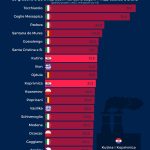Traffic on commercial shipping lines operating on the Adriatic sea last year grew by as much as eighteen percent.
As Poslovni Dnevnik/Sasa Paparella writes on the 5th of September, 2019, in recent years, after shipping companies estimated that connecting some of the most popular tourist destinations during the summer months would be profitable even without government support, an important niche of commercial, seasonal lines opened up.
In total, 744,364 passengers were transported on commercial lines on the Adriatic sea in 2018, which marks an encouraging 17.9 percent increase when compared to 2017’s figures. This year, the result will be even better as the number of such lines has climbed steadily up to ten.
The lack of state aid is also reflected in the price, and a commercial catamaran ticket between Split and Bol costs 100 kuna, while the subsidised ticket is 55 kuna. In these circumstances, the timetable and fare are determined by the shipping companies themselves, which on regular, national lines is made up by the Coastal Shipping Agency (AOLPP).
The most commercial lines, four of them, are held by Kapetan (Captain) Luka, also known as the Krilo brand from the Krilo Jesenice shipyard. Captain Luka connects Split and Dubrovnik with Brač, Hvar, Korč,ula, Makarska and Mljet with catamarans. They have three catamarans that can accommodate 350 passengers each, and a trimaran, the Wing eclipse, with a capacity of 450 passengers and a speed of up to 43 knots.
Captain Luka also maintains a regular high-speed line, Korčula – Hvar – Split. Their revenue is growing strongly, from 57.8 million kuna in 2017 to 76 million kuna last year. In addition, their profits doubled to 8.8 million kuna.
”We’re planning to rejuvenate our fleet with three new ships and introduce some new lines. Seasonal commercial lines are where we started out, and they were almost undefined by the AOLPP rules. This year, we expect an increase of up to 5 percent in terms of our overall business, which is increasingly reducing the share of boat rentals and increasing the share in seasonal line deals,” Luka Tomić stated.
Two commercial lines are also owned by Jadrolinija, which has modernised itself with Jelena catamarans (403 passenger capacities, speeds up to 40 knots) and Vida (304 passengers, 32 knots).
It was on Jadrolinija’s Split-Hvar line that the most passengers were transported last year out of all commercial lines, and from the end of April to the end of October, there were 208,372 passengers transported in total.
Jadrolinija recorded record business results last year, with 951 million kuna in revenue, 100 million kuna more than in 2016. That state-owned shipping company, which has 2,076 employees, remained at 81 million kuna in terms of recorded net profit. Last year, Jadrolinija carried 86 percent of all passengers and 89.4 percent of all vehicles on state lines.
”We carried 12.3 million passengers and 3.1 million vehicles, which is our best traffic ever. Our white fleet, with a capacity of 30,000 passengers and 4,000 vehicles, placed Jadrolinija in the world’s top 10 shipping lines for passengers,” says David Sopta, CEO of Jadrolinija. This year could be even better, as the number of passengers and vehicles carried by that company had increased by 1.5 percent by the end of August.
In addition to Captain Luka and Jadrolinija, Adriatic Commercial Ferries also holds two commercial lines, a company founded just last year specialising in the fast transport of passengers between Split Airport (Resnik) and Split, Bol and Stari Grad. Transport is performed by a distinctive red catamaran with a capacity of 170 passengers and a speed of 35 knots, and the line is branded as the Split express. Owing to that, Split is now connected to its busy airport by a mere 15-minute ride, and Bol now has a connection with Split five times per day.
The director of the Adriatic fast ferries company, Alan Klanac, the longtime president of Jadrolinija’s board of directors, says the company carried more than 30,000 passengers by August the 25th, 2019, which he is pleased with, adding that more than 13 million kuna will be invested this season, and there will be the opening of yet another new line.
The co-owners are Nordic HSCO AB from Sweden and Alveus from Rijeka, Croatia. More and more lines are connecting destinations along the Adriatic coast as time goes on, thus doing a better job avoiding traffic jams. One Norwegian company already had the proper licenses for the introduction of a Zadar – Šibenik – Split line this year, but they were unable to find a suitable vessel, so the project was unfortunately delayed.
One commercial line is maintained by Vrgada RPZ, which runs between the island of the same name and Biograd, as well as the Zadar-based G&V line Iadera, with its new seasonal line Rijeka – Krk – Lopar – Novalja – Zadar. Along with this line, the G&V line Iadera also holds three state-owned lines.
In total, there are fifteen concessionaires on the agency’s list, several of which maintain only one line. Šibenik City Parking holds a connection between Brodarica and the island of Krapanj, while the line to Biševo, with only 8,000 passengers a year, is maintained by the Komiža Nautical Centre.
Make sure to follow our dedicated travel and lifestyle page for much more on Adriatic sea connections up and down the coast.








